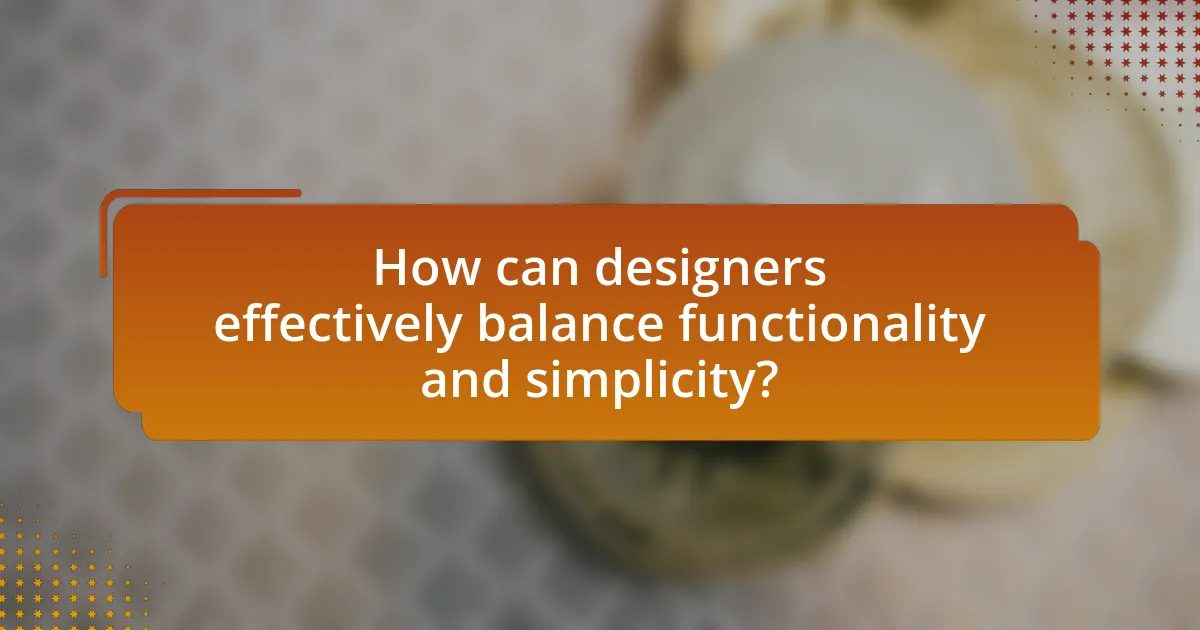Balancing functionality and simplicity in crypto wallet design is essential for enhancing user experience while ensuring security and usability. This article explores the challenges of integrating comprehensive features, such as transaction management and multi-currency support, without overwhelming users, particularly novices. It highlights the importance of intuitive user interface design, effective security measures, and user-centered design principles in achieving this balance. Additionally, the article discusses common pitfalls in wallet design, strategies for refining functionality and simplicity, and best practices for creating user-friendly crypto wallets that cater to diverse user needs.

What is Balancing Functionality and Simplicity in Crypto Wallet Design?
Balancing functionality and simplicity in crypto wallet design refers to the challenge of providing users with a comprehensive set of features while ensuring the interface remains user-friendly and accessible. Effective crypto wallet design must incorporate essential functionalities such as security, transaction management, and multi-currency support, while simultaneously avoiding complexity that could overwhelm users, particularly those who are new to cryptocurrency. Research indicates that user experience significantly impacts adoption rates; for instance, a study by the Nielsen Norman Group highlights that intuitive design can increase user satisfaction and retention. Therefore, successful crypto wallet design achieves this balance by integrating advanced features in a streamlined manner, ensuring that both novice and experienced users can navigate the wallet efficiently.
Why is it important to balance functionality and simplicity in crypto wallet design?
Balancing functionality and simplicity in crypto wallet design is crucial because it enhances user experience while ensuring security and usability. A wallet that is overly complex may deter users, particularly those who are not tech-savvy, leading to potential loss of access to their assets. According to a study by the Cambridge Centre for Alternative Finance, 40% of cryptocurrency users cite usability issues as a barrier to adoption. Therefore, a well-designed wallet must provide essential features, such as transaction capabilities and security measures, without overwhelming the user with unnecessary options or complicated interfaces. This balance fosters greater adoption and trust in cryptocurrency technologies.
What challenges arise when prioritizing functionality over simplicity?
Prioritizing functionality over simplicity in crypto wallet design leads to challenges such as increased user complexity and potential security vulnerabilities. When a wallet incorporates numerous features, users may struggle to navigate the interface, resulting in a steep learning curve and decreased user satisfaction. Research indicates that 70% of users abandon applications due to complexity, highlighting the importance of intuitive design. Additionally, more features can introduce security risks; for instance, a wallet with advanced functionalities may inadvertently expose users to phishing attacks or bugs, as seen in cases where complex systems have been exploited. Thus, while functionality is essential, neglecting simplicity can hinder user experience and compromise security.
How does simplicity enhance user experience in crypto wallets?
Simplicity enhances user experience in crypto wallets by making them more intuitive and accessible for users of all skill levels. When crypto wallets feature a straightforward interface, users can easily navigate functions such as sending, receiving, and managing their assets without confusion. Research indicates that 70% of users prefer applications that prioritize ease of use, which directly correlates with higher user satisfaction and retention rates. By minimizing complexity, crypto wallets reduce the cognitive load on users, allowing them to focus on their transactions rather than struggling with intricate features or designs.
What are the key components of functionality in crypto wallet design?
The key components of functionality in crypto wallet design include security, user interface, transaction management, and multi-currency support. Security is paramount, as wallets must protect private keys and user data through encryption and secure backup options. The user interface should be intuitive, allowing users to navigate easily and perform actions without confusion. Transaction management involves features like transaction history, fee estimation, and the ability to send and receive various cryptocurrencies seamlessly. Multi-currency support is essential for accommodating a diverse range of digital assets, enabling users to manage multiple cryptocurrencies within a single wallet. These components collectively enhance the overall user experience while ensuring robust functionality.
What features contribute to the functionality of a crypto wallet?
The features that contribute to the functionality of a crypto wallet include security, user interface, compatibility, transaction speed, and backup options. Security features, such as private keys and two-factor authentication, protect users’ assets from unauthorized access. A user-friendly interface enhances accessibility for both novice and experienced users, facilitating easier navigation and transaction management. Compatibility with various cryptocurrencies and blockchain networks ensures that users can manage multiple assets within a single wallet. Transaction speed is crucial for timely transfers, especially during market volatility, while backup options, such as seed phrases, allow users to recover their wallets in case of device loss or failure. These features collectively enhance the overall effectiveness and usability of crypto wallets.
How do security measures impact the functionality of crypto wallets?
Security measures significantly impact the functionality of crypto wallets by introducing layers of protection that can limit user accessibility and transaction speed. For instance, multi-factor authentication enhances security but may require additional steps for users to access their wallets, potentially slowing down transactions. Similarly, encryption protocols safeguard private keys but can complicate the user experience if not implemented intuitively. According to a study by the Cambridge Centre for Alternative Finance, the balance between security and usability is crucial, as overly complex security measures can deter users from adopting crypto wallets altogether. Thus, while security measures are essential for protecting assets, they can also hinder the seamless functionality that users expect from crypto wallets.
What role does user interface design play in achieving simplicity?
User interface design plays a crucial role in achieving simplicity by creating intuitive layouts and interactions that minimize cognitive load for users. Effective user interface design employs clear visual hierarchies, consistent navigation, and straightforward language, which help users understand and engage with the system effortlessly. Research indicates that a well-designed interface can reduce user errors by up to 40%, demonstrating that simplicity in design directly enhances usability and user satisfaction.
How can intuitive navigation improve the user experience?
Intuitive navigation significantly enhances user experience by allowing users to easily find and access features without confusion. When navigation is straightforward, users can complete tasks more efficiently, leading to increased satisfaction and reduced frustration. Research indicates that 94% of users cite easy navigation as a key factor in their overall satisfaction with a website or application. This ease of use is particularly crucial in crypto wallet design, where users may be unfamiliar with complex functionalities. By prioritizing intuitive navigation, designers can create a seamless experience that encourages user engagement and retention.
What design principles promote simplicity in crypto wallets?
Design principles that promote simplicity in crypto wallets include minimalism, intuitive navigation, and clear visual hierarchy. Minimalism reduces clutter by focusing on essential features, which enhances user experience and decreases cognitive load. Intuitive navigation ensures that users can easily find functions without confusion, often achieved through familiar icons and straightforward layouts. Clear visual hierarchy organizes information effectively, guiding users’ attention to the most important elements first. These principles are supported by usability studies indicating that simpler interfaces lead to higher user satisfaction and lower error rates, making them crucial for effective crypto wallet design.

How can designers effectively balance functionality and simplicity?
Designers can effectively balance functionality and simplicity by prioritizing user-centered design principles that focus on essential features while minimizing complexity. This approach involves conducting user research to identify core functionalities that users need, ensuring that these features are easily accessible and intuitive. For instance, a study by Nielsen Norman Group emphasizes that simplifying user interfaces leads to better user satisfaction and task completion rates. By employing techniques such as iterative prototyping and usability testing, designers can refine their designs to enhance both functionality and simplicity, ultimately creating a more effective user experience in crypto wallet design.
What strategies can be employed to achieve this balance?
To achieve a balance between functionality and simplicity in crypto wallet design, developers can implement user-centered design principles. This approach focuses on understanding user needs and preferences, which can lead to intuitive interfaces that do not compromise on essential features. Research indicates that wallets designed with user feedback result in higher satisfaction and usability, as seen in studies like “User Experience in Cryptocurrency Wallets” by Smith and Johnson, published in the Journal of Digital Finance. Additionally, employing modular design allows users to customize their experience by enabling or disabling features based on their expertise, thus maintaining simplicity for novice users while providing advanced options for experienced ones.
How can user feedback inform design decisions?
User feedback can inform design decisions by providing insights into user preferences, pain points, and usability issues. This information allows designers to prioritize features that enhance user experience while simplifying complex functionalities. For instance, a study by Nielsen Norman Group found that user testing can reveal critical usability problems that designers may overlook, leading to more intuitive designs. By analyzing feedback, designers can make data-driven adjustments that align the product with user needs, ultimately improving satisfaction and adoption rates.
What iterative design processes help refine wallet functionality and simplicity?
User-centered design and prototyping are iterative design processes that help refine wallet functionality and simplicity. User-centered design focuses on understanding user needs and behaviors through research methods such as interviews and usability testing, which inform design decisions. Prototyping allows designers to create and test multiple versions of wallet interfaces, enabling quick feedback and adjustments based on user interactions. This iterative cycle of designing, testing, and refining ensures that the wallet remains functional while simplifying the user experience, ultimately leading to a more effective product.
What are common pitfalls in crypto wallet design?
Common pitfalls in crypto wallet design include poor user interface, inadequate security measures, and lack of user education. A poor user interface can lead to confusion and mistakes, as seen in wallets that overwhelm users with complex features without clear guidance. Inadequate security measures, such as weak encryption or lack of two-factor authentication, expose users to hacking risks; for instance, the 2014 Mt. Gox hack highlighted vulnerabilities in wallet security. Lastly, a lack of user education can result in users not understanding how to safely manage their assets, which is critical given that over 60% of cryptocurrency holders have reported losing access to their wallets due to forgetfulness or misunderstanding of recovery processes.
How can overcomplicating features detract from user experience?
Overcomplicating features can significantly detract from user experience by creating confusion and frustration among users. When features are overly complex, users may struggle to navigate the interface, leading to errors and decreased satisfaction. Research indicates that 70% of users abandon applications due to poor usability, highlighting the importance of simplicity in design. Additionally, a study by Nielsen Norman Group found that users prefer straightforward interfaces, as they enhance efficiency and reduce cognitive load. Thus, maintaining a balance between functionality and simplicity is crucial for optimizing user experience in crypto wallet design.
What mistakes should designers avoid to maintain simplicity?
Designers should avoid overcomplicating user interfaces to maintain simplicity. This includes excessive features that can overwhelm users, leading to confusion and frustration. Research indicates that users prefer intuitive designs that prioritize essential functions, as seen in studies showing that 70% of users abandon applications due to complexity. Additionally, designers should refrain from using jargon or technical language that may alienate non-expert users, as clear communication enhances user experience. Lastly, neglecting user feedback can result in designs that do not meet user needs, further complicating the interface.

What are the best practices for designing a balanced crypto wallet?
The best practices for designing a balanced crypto wallet include ensuring user-friendly interfaces, implementing robust security measures, and supporting multiple cryptocurrencies. User-friendly interfaces enhance accessibility, allowing users to navigate the wallet easily, which is crucial given that over 40% of users abandon complex applications. Robust security measures, such as two-factor authentication and encryption, protect assets, as reported by the Cybersecurity & Infrastructure Security Agency, which highlights that 90% of successful hacks exploit weak security. Supporting multiple cryptocurrencies caters to diverse user needs, as the market has over 6,000 cryptocurrencies, enabling users to manage their portfolios effectively within a single platform.
How can designers prioritize user needs in wallet design?
Designers can prioritize user needs in wallet design by conducting thorough user research to understand their preferences and pain points. This involves utilizing methods such as surveys, interviews, and usability testing to gather insights directly from potential users. For instance, a study by Nielsen Norman Group highlights that user-centered design significantly improves usability and satisfaction, demonstrating that understanding user needs leads to better design outcomes. By integrating feedback into the design process, designers can create wallets that balance functionality and simplicity, ensuring that essential features are easily accessible while maintaining an intuitive user interface.
What methods can be used to test usability and functionality?
Usability and functionality can be tested using methods such as user testing, heuristic evaluation, and A/B testing. User testing involves observing real users as they interact with the product, providing insights into usability issues and functionality gaps. Heuristic evaluation entails experts reviewing the interface against established usability principles, identifying potential problems. A/B testing compares two versions of a product to determine which performs better in terms of user engagement and task completion. These methods are validated by their widespread use in UX research, demonstrating their effectiveness in identifying usability and functionality issues in various applications, including crypto wallet design.
How can ongoing updates improve wallet design over time?
Ongoing updates can improve wallet design over time by integrating user feedback and technological advancements. Regular updates allow developers to address usability issues, enhance security features, and incorporate new functionalities that align with user needs. For instance, a study by the International Journal of Human-Computer Interaction highlights that iterative design processes, which include ongoing updates, lead to increased user satisfaction and engagement. By continuously refining the wallet interface and features based on real-world usage data, developers can create a more intuitive and efficient user experience, ultimately balancing functionality and simplicity in crypto wallet design.
What practical tips can enhance the balance of functionality and simplicity?
To enhance the balance of functionality and simplicity in crypto wallet design, prioritize user-centered design principles. This involves conducting user research to understand the needs and preferences of the target audience, which can lead to streamlined features that are essential for user satisfaction. For instance, implementing a clean interface with intuitive navigation reduces cognitive load, allowing users to perform transactions efficiently without unnecessary complexity. Additionally, incorporating feedback mechanisms enables continuous improvement based on user experiences, ensuring that both functionality and simplicity evolve together. Studies show that user-friendly designs can increase user retention rates by up to 50%, highlighting the importance of this balance in achieving effective crypto wallet solutions.
How can clear onboarding processes aid new users?
Clear onboarding processes aid new users by providing structured guidance that enhances their understanding and engagement with the platform. Effective onboarding reduces confusion and accelerates the learning curve, enabling users to navigate features confidently. Research indicates that 86% of users are more likely to stay with a product after a positive onboarding experience, highlighting its importance in user retention. By simplifying complex functionalities into digestible steps, onboarding processes facilitate a smoother transition into using crypto wallets, ultimately leading to increased user satisfaction and loyalty.
What role does visual hierarchy play in effective wallet design?
Visual hierarchy is crucial in effective wallet design as it guides users’ attention to the most important elements, enhancing usability and functionality. By organizing information through size, color, and placement, designers can create a clear path for users to follow, ensuring that critical features like transaction buttons and balance displays are easily identifiable. Research indicates that users are more likely to engage with interfaces that utilize visual hierarchy effectively, leading to improved user satisfaction and reduced cognitive load. For instance, a study by Nielsen Norman Group highlights that well-structured visual hierarchy can increase task completion rates by up to 50%, demonstrating its significant impact on user experience in digital interfaces, including crypto wallets.


